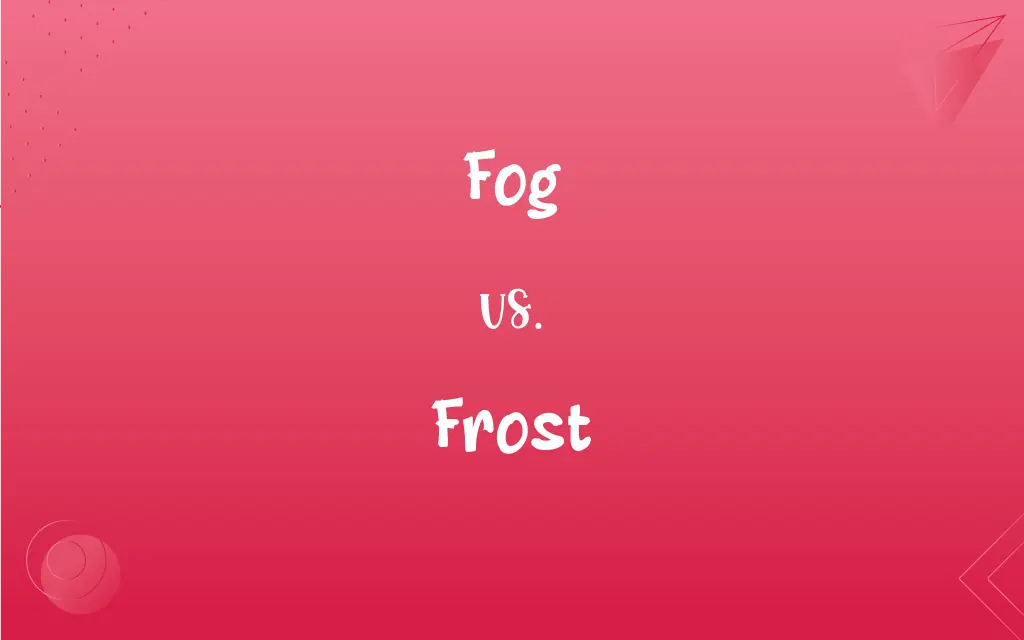Fog vs. Frost: What's the Difference?
Edited by Janet White || By Harlon Moss || Updated on November 6, 2023
Fog is a cloud that reaches the ground, while frost is the ice crystals formed by freezing water vapor on surfaces.

Key Differences
Fog is a meteorological condition characterized by extremely low visibility due to a cloud of tiny water droplets suspended in the air at or near the Earth's surface. Frost, on the other hand, occurs when water vapor from the air comes into contact with cold surfaces, freezing into ice crystals. This process is known as deposition, which bypasses the liquid phase entirely.
While fog creates a shroud that can envelop landscapes, making it difficult to see, frost decorates objects with a crystalline layer of ice, often sparkling in the light. Both phenomena require specific conditions of humidity and temperature; fog typically forms when the air is cool and the humidity is high, whereas frost forms when surfaces cool below the dew point of the surrounding air and below freezing.
Visibility is the primary concern with fog as it can dramatically reduce the range of sight for drivers, pilots, and mariners. In contrast, frost does not impact visibility but can affect driving conditions by making surfaces slippery. It can also cause damage to sensitive plants and crops.
Both fog and frost are common in certain climates, particularly during the transition from night to day. Fog often occurs in the morning when the air temperature drops during the night then warms quickly at sunrise, causing condensation. Frost typically forms on clear, cold nights when objects lose heat by radiation more quickly than the surrounding air.
Comparison Chart
Definition
A dense cloud of water droplets
A coating of ice crystals
ADVERTISEMENT
Formation
Condensation of water vapor
Freezing of water vapor (deposition)
Temperature
Above freezing, near ground level
Below freezing, on surfaces
Visibility Impact
Reduces visibility significantly
Does not affect visibility
Conditions for Formation
High humidity, low temperatures
Low temperatures, clear skies
Occurrence
Often during mornings/evenings
Typically on clear and cold nights
ADVERTISEMENT
Physical State
Liquid droplets
Solid ice crystals
Interaction with Light
Scatters and absorbs light
Reflects light, often glistening
Impact on Driving
Reduced sight, potential hazards
Slippery surfaces, potential hazards
Agricultural Relevance
May provide needed moisture
Can damage or kill crops by freezing
Fog and Frost Definitions
Fog
Something that obscures and confuses a situation or someone's thought processes.
The medicine left her in a fog for most of the day.
Frost
A condition of freezing or being frozen.
The early frost caught the farmers off guard.
Fog
Condensed water vapor in cloud-like masses close to the ground.
The fog was so thick this morning that I couldn't see the end of my driveway.
Frost
Coldness in the atmosphere like that of a freezing temperature.
The frost in the air nipped at their faces.
Fog
A mass of fine droplets of liquid in the atmosphere at ground level.
The headlights barely cut through the dense fog.
Frost
To cover with or as if with a frost, especially to coat glass to make it opaque.
The windows were frosted for privacy.
Fog
A cloud of something that resembles fog.
The room was filled with a fog of smoke from his cigarette.
Frost
A deposit of small white ice crystals formed on the ground or other surfaces.
The grass was covered in a blanket of frost this morning.
Fog
A state of mental vagueness or bewilderment.
He spent the morning in a fog, trying to remember the previous night.
Frost
A deposit of minute ice crystals formed when water vapor condenses at a temperature below freezing.
Fog
Condensed water vapor in cloudlike masses lying close to the ground and limiting visibility.
Frost
A period of weather when such deposits form.
Fog
An obscuring haze, as of atmospheric dust or smoke.
Fog
A mist or film clouding a surface, as of a window, lens, or mirror.
FAQs
What causes fog?
Fog is caused by the condensation of water vapor in the air near the Earth's surface.
Is fog a type of cloud?
Yes, fog is considered a type of cloud that forms close to the ground.
Can fog occur indoors?
Yes, fog can form indoors in large, humid spaces such as indoor pools.
How can fog be dangerous?
Fog can reduce visibility drastically, leading to dangerous driving and boating conditions.
What is a frost pocket?
A frost pocket is a low-lying area where cold air settles and frost is more likely to form.
What kind of weather is associated with fog?
Fog typically occurs in calm weather with little wind and high humidity.
Can frost form when the temperature is above freezing?
No, frost formation requires temperatures below the freezing point of water.
Can frost be predicted?
Yes, meteorologists can predict frost by analyzing temperature forecasts, humidity levels, and sky conditions.
Does fog affect air travel?
Yes, fog can lead to flight delays and cancellations due to poor visibility.
Can frost be beneficial?
Frost can sometimes be beneficial by killing pests and disease-causing organisms.
Is frost only a winter phenomenon?
While more common in winter, frost can occur any time the conditions are right, such as on cold spring or fall nights.
Can fog form over water?
Yes, fog can form over water, often called sea fog or steam fog.
What causes frost?
Frost is formed when the temperature drops below freezing and water vapor in the air directly deposits as ice crystals on surfaces.
How does frost affect plants?
Frost can damage or kill plants by causing ice crystals to form within the plant tissue, which disrupts the movement of fluids.
Are there different types of frost?
Yes, common types include hoar frost, window frost, and rime.
Is fog more common at certain times of the day?
Yes, fog is most common in the early morning and evening hours.
What are some types of fog?
Common types include radiation fog, advection fog, and evaporation fog.
What is the difference between frost and dew?
Dew forms when water vapor condenses into liquid, while frost forms when water vapor freezes into ice.
What is "freezing fog"?
Freezing fog is composed of droplets that freeze upon contact with objects, forming a layer of rime.
What is black frost?
Black frost refers to a condition where frost formation is invisible, and plant tissue freezes without a visible layer of ice.
About Author
Written by
Harlon MossHarlon is a seasoned quality moderator and accomplished content writer for Difference Wiki. An alumnus of the prestigious University of California, he earned his degree in Computer Science. Leveraging his academic background, Harlon brings a meticulous and informed perspective to his work, ensuring content accuracy and excellence.
Edited by
Janet WhiteJanet White has been an esteemed writer and blogger for Difference Wiki. Holding a Master's degree in Science and Medical Journalism from the prestigious Boston University, she has consistently demonstrated her expertise and passion for her field. When she's not immersed in her work, Janet relishes her time exercising, delving into a good book, and cherishing moments with friends and family.































































